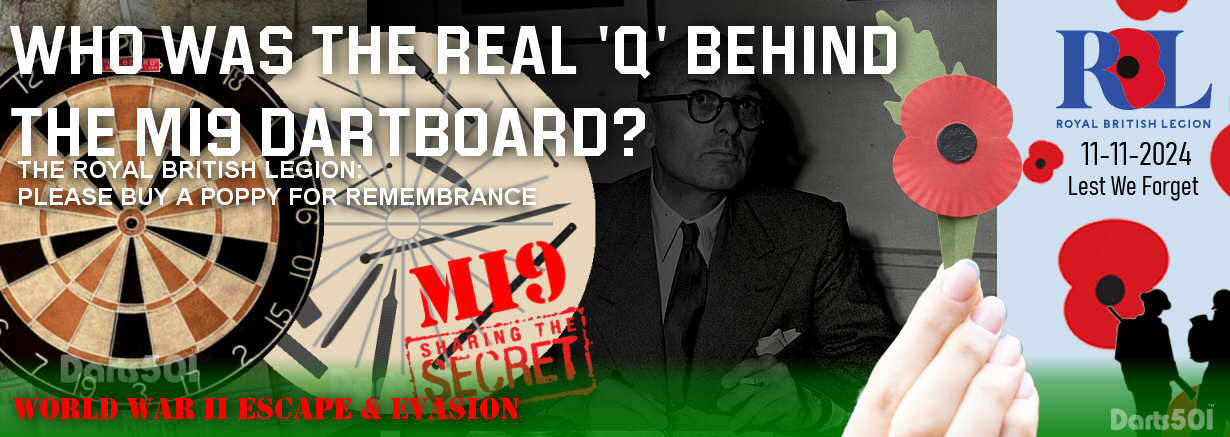
MI9 – World War II Escape and Invasion Dartboard
Many have heard of MI5 and MI6 British Intelligence, but say MI9 and most people wouldn’t have heard of this wing of the intelligence department. MI9 role in World War II, amongst other things, was to help the PoW escape their capturers by providing ‘James Bond’, ‘Q’ escape tools, maps, ID and money. It has been a fascinating topic to read about and explore. Although I am no expert in the history of MI9, I have had some help from people who are to help create and verify my research into one of the escape tools MI9 provided PoWs.
World War II, VE Day - 1945-2020, 75th Anniversary
2020 was the 75th anniversary of Victory in Europe (VE Day). To mark this occasion, I created a new history page looking at darts propaganda dartboards, and a look at British Intelligence MI9 involvement with PoWs escape methods with the help of the popular game darts! During my research, I came across a board I have never seen before know as the Blitzkrieg Dartboard. However, I have no information other than ARP Suppliers apparently supplied it as a recreational aid. If you know anything about this dartboard, please let me know.
To help, I have digitally reproduced the Blitzkrieg dartboard in the hope someone may recognise the layout. Please see below.
World War II - Wartime Dartboards
War should never be glorified, in my opinion. However, it was within these years that darts became a global game. Although darts in the UK had existed for many years before World War One, it was soldiers stationed in the UK that got a taste for our beer and pub games. Darts, of course, was a big hit and many boards made their way around the world.
War historians will also tell you that dartboards, along with other games and sports equipment, were used to smuggle silk maps, currency, tools, fake identification documents, and other materials to prisoners of war. In brief, MI9 was UKs Military Intelligence department responsible for the supply of such escape aids.
The Role of MI9 in World War II, Aid, Secrets, and the 'Gilboard', Dartboard 1939-1945
MI9 was created on 23 December 1939 and was headed by Brigadier Norman Crockatt throughout its existence. MI9 aim was facilitating the escape of British prisoners of war (PoWs), and their return to the UK. They would train service personnel on escape and evasion techniques and help the morale of PoWs by remaining in contact with them during their captivity.
Brigadier Crockatt set out the Branch's philosophy of 'escape-mindedness' which became the focus of the training programme as It was every man's duty to try to escape, and MI9 would do everything they could to support them.
One of the earliest appointments Crockatt made was Christopher Clayton Hutton as his Technical Officer. Hutton was the inventor of escape aids until 1943 when he retired on health grounds.
Many readers would have heard of Ian Fleming, writer of the infamous James Bond 007 novels. Ian joined British Naval Intelligence in 1939. However, the Real Q, was Christopher Hutton the boffin enlisted to aid MI9.
MI9 enlisted manufacturers of leisure items as board games, playing cards, chess sets, gramophone records, dartboards, table tennis and cricket bats to help them hide the maps, and escape equipment inside such items during their manufacture.
Companies such as John Waddington & Co made games, and playing cards with silk and paper maps hidden between the layers of card and playing boards. Monopoly was one such game. A full stop at the end of one of the place names would indicate to the trained eye the type of map the board would hold. Using the Monopoly game as a carrier for maps was useful as an actual currency could be hidden with the Monopoly money as escapers needed local currency if their attempts were to stand any chance of success.
Maps were smuggled into PoW war camps in many game's ludo, snakes and ladders, draughts, cribbage boards, chess sets, playing cards, pencils and even gramophone records. Sports equipment such as table tennis, cricket bats and balls and dartboards could also hold hidden maps, mini saws and other escape equipment.
MI9 invented entirely fictitious cover organisations such as the Licensed Victuallers' Sports Association, the Prisoners' Leisure Hour Fund, the Ladies Knitting Circle, The Jigsaw Puzzle Club. Each of these had headed notepaper and real, but with fictitious addresses. The 'GILBOARD’ Dartboard may have also been one such fictitious cover.
The Germans were also useful as they allowed the PoWs to send back signed receipts for the parcels, which allowed MI9 to track what was getting through to each camp.
The Geneva Convention allowed delivery of parcels to be sent to the prisoner of war camps for the PoWs both the Red Cross and the PoWs families. MI9 vowed that they would never compromise either of these by sending their escape materials hidden inside their parcels and they never did.
The ‘Gilboard’ MI9 Dartboard
Dartboards were used to supply PoWs a lot of tools. These would have included, saw blades, screwdrivers, files, gigli saw, and a raft of other equipment. The outer playing surface of the dartboard was made from cork. Cork was a common material used for dartboard manufacturer at the time unlike the more common sisal of today.
Darts supplied with the boards also contained secrete items such as compasses. The barrel of the dart split in two with the help of a right-hand thread to reveal the contraband.
The illustrations below show how a dartboard was designed to be taken apart to reveal the hidden treasure. The dartboard was made by ‘GILBOARD’ and supplied by family-run toy supplier, along with other games by Jacques of London they would have supplied ‘normal’ dartboards so not all contained the tools for PoWs.
Jacques supplied not only dartboards but also dartboard cabinets which gave MI9 an increased opportunity to hide even more escape equipment.
MI9 used the services of former stage magician Jasper Maskelyne to design hiding places for escape aids including tools hidden in cricket bats and baseball bats, maps concealed in playing cards and actual money in board-games. It is suspected Maskelyne also came up with the idea of using a dartboard as a means of concealment of escape tools.
Maskelyne joined the Royal Engineers when the second World War broke out and thought his skills as an illusionist could concealment and camouflage. He convinced skeptical officers by creating the illusion of a German warship on the Thames using mirrors and a model.
Brigadier Dudley Clarke, the head of the 'A' Force deception department, recruited Maskelyne to work for MI9 in Cairo where he created small devices intended to assist soldiers to escape if captured and lectured on escape techniques.
MI9 'GILBOARD' Dartboard with hidden compartment

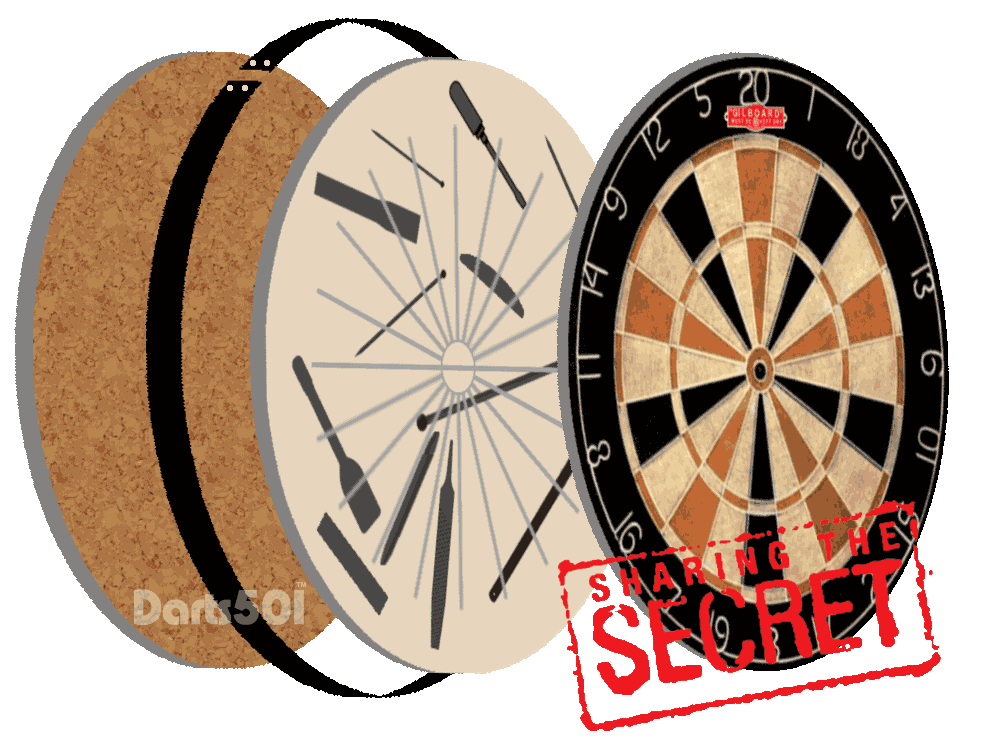
How the tools were hidden and arranged between layers of the dartboard


GILBOARD, is still a bit of a mystery and it could have been a name used as MI9 cover? However, MI9 gave plans for to the USA when they came into the war. The USA MI wanted to get up to speed as soon as possible on espionage tactics because they needed these sorts of inventions for their prisoners of war in the Far East and several ideas were copied for their use.
GILBOARD Dartboards were also distributed and sold via ABERCROMBIE & FITCH CO. New York. Although should you ever find one of these boards do not automatically assume it contains hidden tools. MI9 not only had supplied games and sports equipment with hidden contraband, but they also supplied unaltered pieces referred too as ‘Dove’ equipment. The ‘Dove’ equipment was supplied not only to provide a fun game but also to reduce the chances of the PoWs captors discovering contraband in other games.
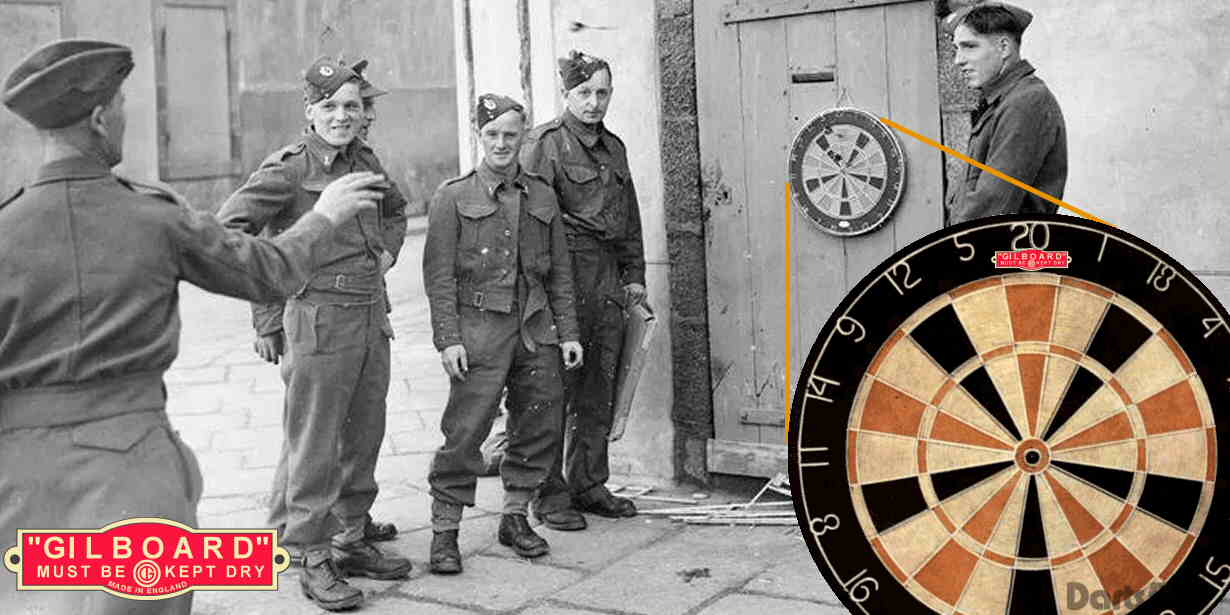
The positioning of the GILBOARD Made in England Logo may have indicated whether the dartboard supplied was a standard dartboard or a special edition MI9 version containing hidden PoW escape tools.
The photo above show soldiers having a game of darts on a GILBOARD dartboard, note the position of the logo, and although the photo is not in colour you can clearly see the logo is placed at the bottom on a dark segment. The MI9 reconstructed image taken from the MI9 archive positions the logo at the top of the board above a light segment. Unlike modern-day dartboards, these board had a top wire to hang the dartboard from a nail or screw. The position of the logo may have been the board type indicator!
MI9 Historians
Research into darts and any sport can be interesting, and I didn't think the game would take me into the realms of espionage and PoWs escape devices. Indeed this area of research has been fascinating, although it has also taken months to compile. I would, however, like to express my thanks to the staff at the Imperial War Museum, Bletchly Park and MI9 Historian, writer Dr Helen Fry and Phil Froom..
Dr Helen Fry has written numerous books on the second world war and undertakes consultancy work for documentary companies and as a consultant historian for location filming of WWII scenes for several TV channels including BBC, ITV and Channel 4.
She has also been engaged in a range of more comprehensive historical projects, including for schools curriculum and adult education, relating to WW1, WWII and The Cold War.
Helen is an Honorary Member of The Association of Jewish Refugees and an Associate Editor for 'Eye Spy Magazine'.
Helen is also an ambassador for the Museum of Military Intelligence.
My thanks to Helen for her help in my research. If you would like to learn more about MI9, or indeed the 10,000 Germans and Austrians who fought for Britain, then please visit Dr Helen Fry's website to view a list of books on the subject.
If you are interested in a broader range of MI9, MIS-X and SOE escape and evasion devices, then you might wish to purchase a copy of a book written by Phil Froom titled 'Evasion and Escape Devices By MI9, MIS-X and SOE in World War II'.
Phil contacted me to say fifteen years of research had gone into his book and from my perspective on researching some aspects of the sport of darts I genuinely believe this has been the case.
Phil Froom and David Lyons had a website. However, it seems to have been taken offline. I am therefore providing this video link from the International Spy Museum Curator’s Corner – WWII Escape and Evasion with Phil Froom. Enjoy!
If you have found this page due to your interest in MI9, you will find both Dr Helen Fry and Phil Froom are authorities on this subject.

![]()
Wartime Propaganda Dartboards and Target Board Examples
World War II propaganda dartboards and target games made in the UK and USA 1939-1945
Dartboards, during this period, were also made for home recreational purposes, and such was the game in the UK & USA it was inevitable boards were made illustrating enemy leaders for all to throw a dart at. However, a few were designed as more serious and skilful game.

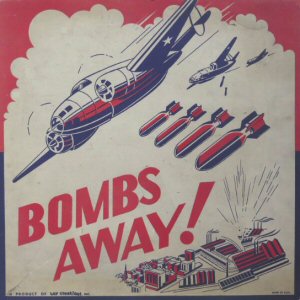
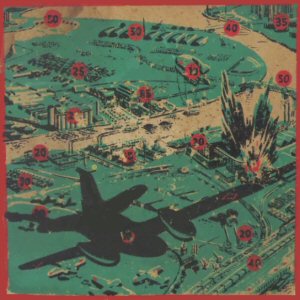
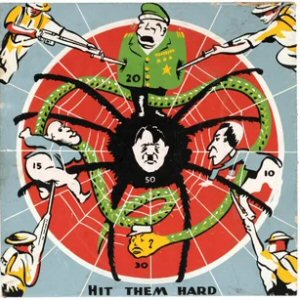



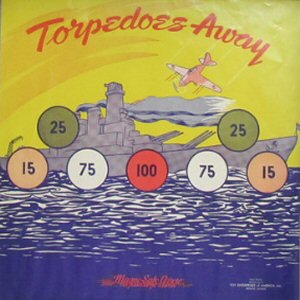
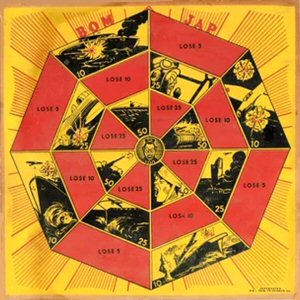
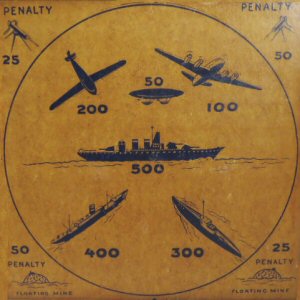
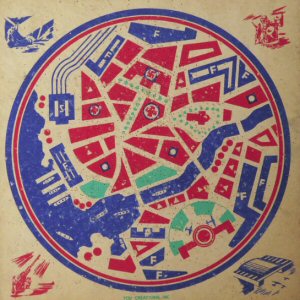
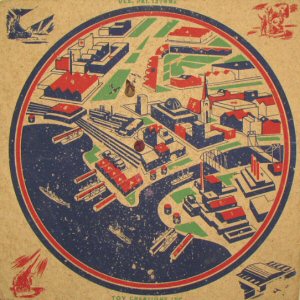
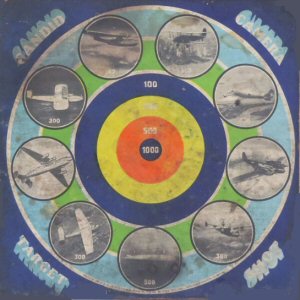
PLONK' - The Welcom Dart Game
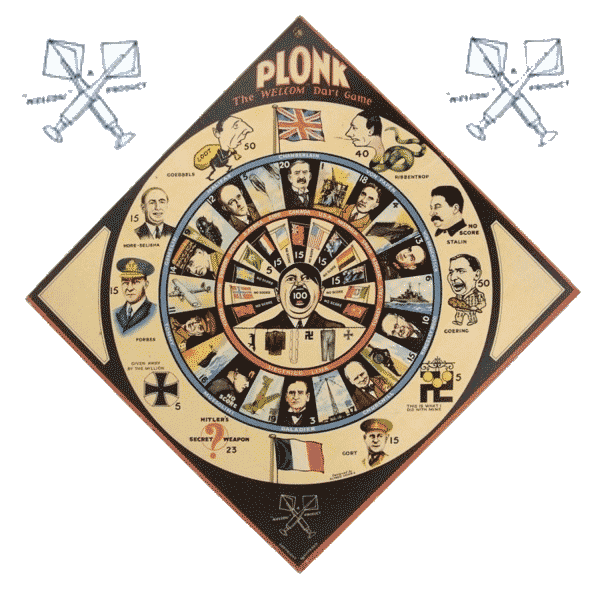
'PLONK' - World War II Propaganda Dart Game.
Alfred Morris designed the Plonk Dartboard for Wartime propaganda purposes. The board was approximately 41 x 41cm square and printed on stiff cardboard.
The board is illustrated with allied and axis figures from 1940-1945 including Goebbels, Goering, Stalin, Ribbentrop, Mussolini, Daladier, Kingsley-Wood, Churchill, Chamberlain, Von Papen etc. with Hitler at the centre.
The darts game 'Plonk' is played using rubber suction type darts by two opponents, individuals or in teams. Each start with a total of 365 points. Each player alternately throws three darts and tries to eliminate the Nazis by hitting their leaders, ships, guns etc. - deducting the number scored from their total.
An alternative version of the game involves aiming at specific targets and 'Knocking out the Nasties'.
![]()
Dartex Playing Cards circa, 1938
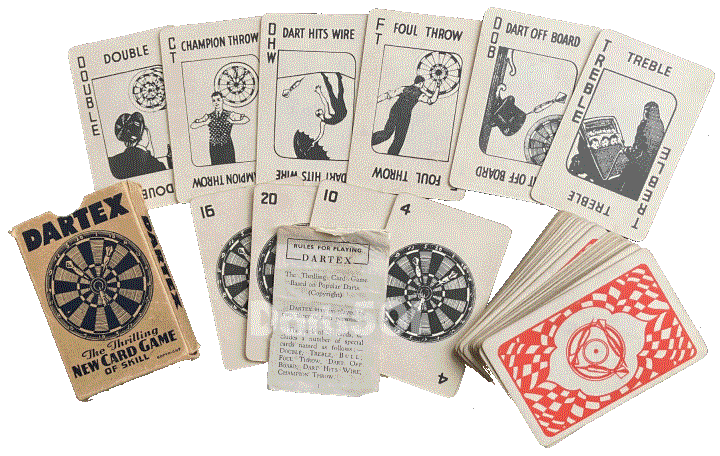
'Dartex' Playing Cards circa, 1938
Dartex, Card Game circa, 1938
'Dartex' is based on the traditional game of darts. The card game version contains 52 cards as per a traditional card pack of playing cards, Heart, Diamonds, Spades and Clubs. Thirty-eight cards feature a dartboard with a number, and the remaining fourteen contain throw instructions, such as Double, Treble, Dart of the Board, Foul Throw, Darts hits the Wire, and Champions Throw. All the cards act as the throws, and, like in the actual game, good mental arithmetic is required.
For this game, it is a double start!
The rules state: For his first throw, every player must begin with a double, such a throw, therefore, being double, 3, 4, or double, 11, 12, etc.
However, in place of a double, a player can use two cards of the same number, e.g., throws made up of 4, 4, 9, or 7, 7, 18, etc. In which case, the duplicated numbers count only as a double for scoring purposes and have no numerical value, e.g., 4, 4, 9, would be scored as a double 9, which equals 18. ... The highest score possible for anyone throw is treble, treble, bull, equals 450, a bit more than the 180!
The game was published, just before World War II, in September 1938. The cards, the pack, nor the instructions feature the publisher or manufacturer's name.
![]()
Throw a Dart for Victory (1940s)
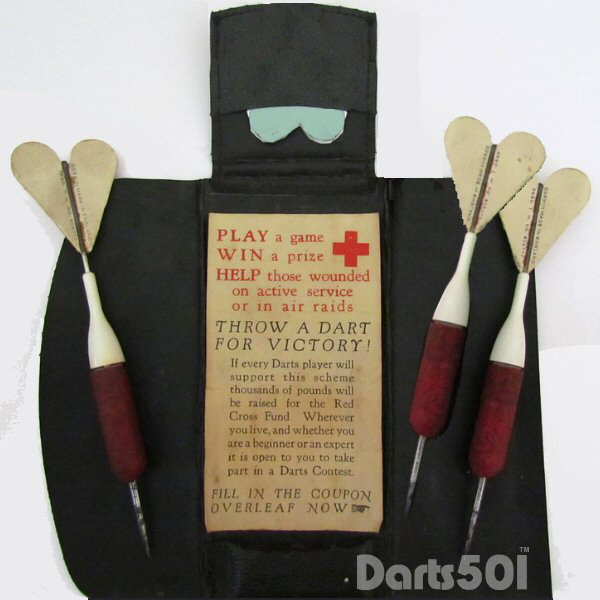
The Red Cross illustrated Darts were made by Dorwin
 RED CROSS Throw a Dart for Victory (1940s)
RED CROSS Throw a Dart for Victory (1940s)
PLAY a game WIN a prize HELP those wounded on active service or in air raids
To raise funds for those who were wounded on active service or in air raids. The Red Cross introduce ‘Throw a Dart for Victory’.
The coupon stated: 'If every Darts player will support this scheme thousands of pounds will be raised for the Red Cross Fund. Wherever you live, and whether you are a beginner or an expert it is open to you to take part in a Darts Contest.'
Red Cross today
![]()
The red cross, red crescent and red crystal are symbols of protection.
International law protects the people who wear them, and the buildings and transport which display them.
These people aren’t part of a conflict – they’re simply there to help anyone who needs it.
The emblems are not religious symbols
British Red Cross - Donate today
![]()
German Propaganda Board Games
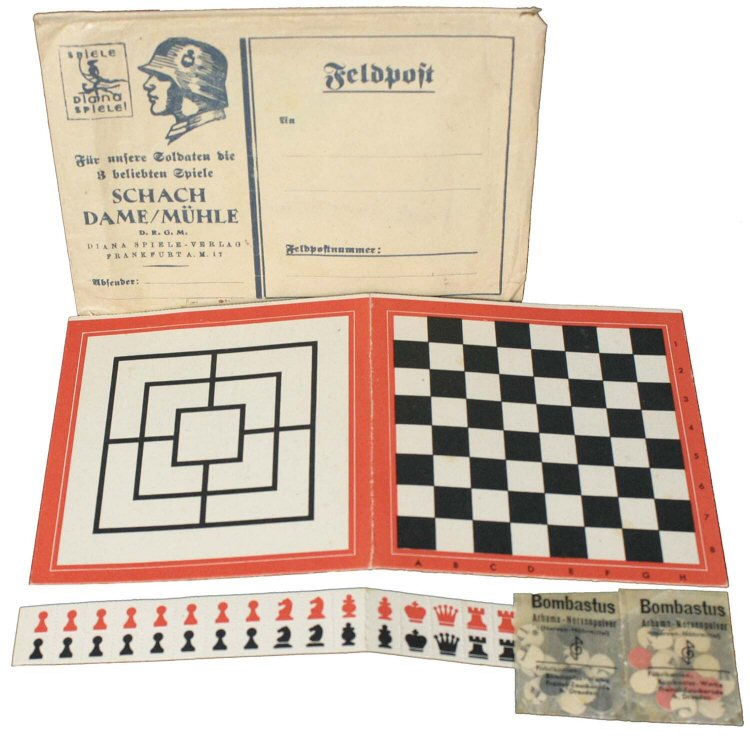
Equally, Germany made propaganda board games and soldiers would have received games during World War II. The games for the front line were generally lightweight and made from paper so they would easily fit in an envelope. These were more likely to be games such as chess and checkers. The envelope would be marked as ‘Feldpost’ (Field Post)
German propaganda games included:
- Mit ‘Prien’ gegen England (Anti England game U-boat Commander Prien)
- Radio Sende Spiel (Wartime Radio Transmissions)
- Das U-Boot Spiel (U-Boat game)
- Das Bunkerspiel (Bunker game)
- Wehrschach Tik-Tak (Military Chess’ for Soldiers, Hitler Youth, SS)
- Kampf und Sieg (Battle and Victory)
- Belagerungsspiel
- Wir Kampf Gegan Den Feind (We Fight Against The Enemy)
- Wir fahren gegen England (We go against England)
- And many more…
Both sides would have used games to help build morale. More details about how some of these games were played and used can be found at: The Nazi Board Games of World War II - Atlas Obscura
![]()
Blitzkrieg Bombardment Dartboard updated section March 2021

The Blitzkrieg Dartboard - Can you help?
The 'Blitzkrieg Bombardment Dartboard' by A.R.P. Suppliers
A dartboard that I have never seen came to light recently, and it was referred to as the Blitzkrieg or Blitzkrieg Bombardment Dartboard, issued by the ARP Supplies during the war for recreational pleasure.
I do not know if this was a board issued for PoWs via MI9, but I guess not. I believe it may just have been a recreational board used in the NAAFI.
While watching Combat Dealers, Series 3, Episode 5, on the Discovery Channel here in the UK, dealer Bruce Crompton purchases a Blitzkrieg Dartboard. Bruce restores old military and combat equipment and sells the restored items on, mainly to collectors and to the film industry. Bruce, a canny Londoner, always looks out for unusual and rare items and the dartboard caught his eye. Bruce obviously knows his military market because he paid £300.00 for this rare example.
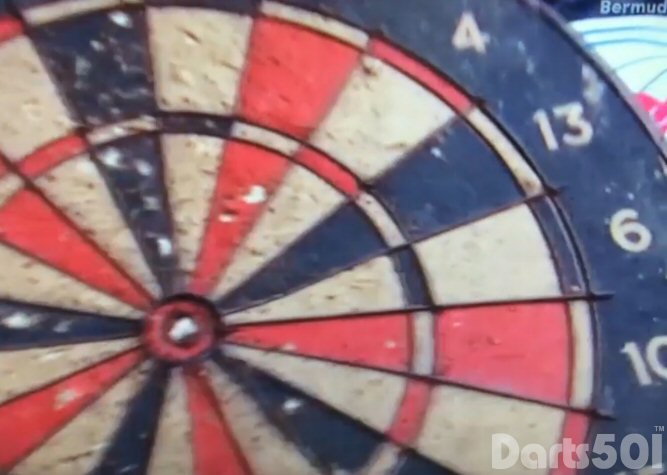
Blitzkrieg Dartboard - Side One

Blitzkrieg Dartboard - Side Two
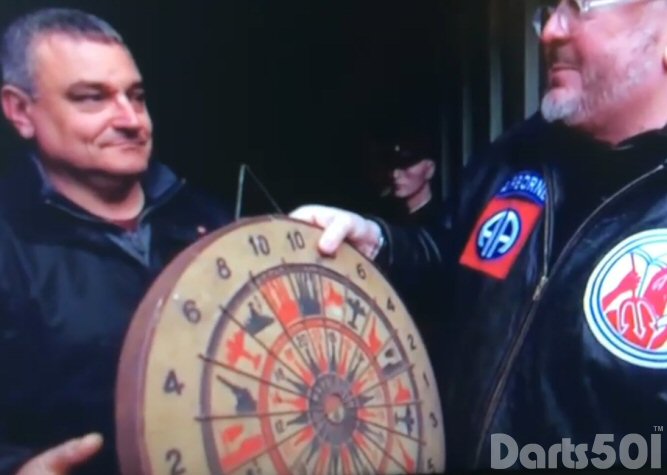
Blitzkrieg Dartboard - Stencil Printed
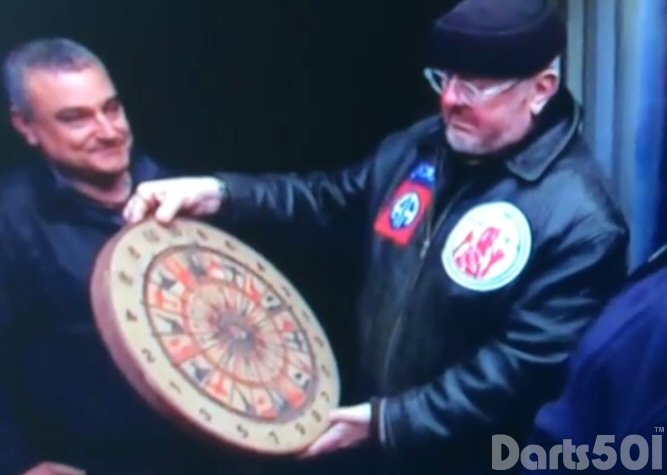
Blitzkrieg Dartboard - ARP Supplies
Blitzkrieg Bombardment Dartboard Digitally Redesigned
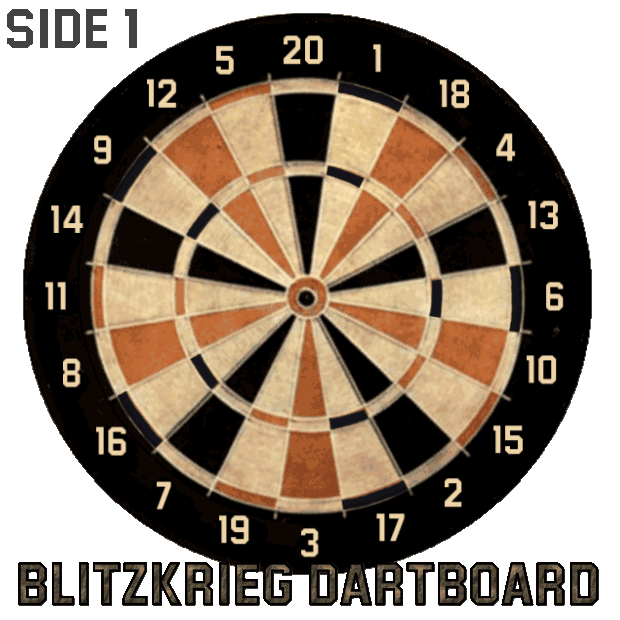
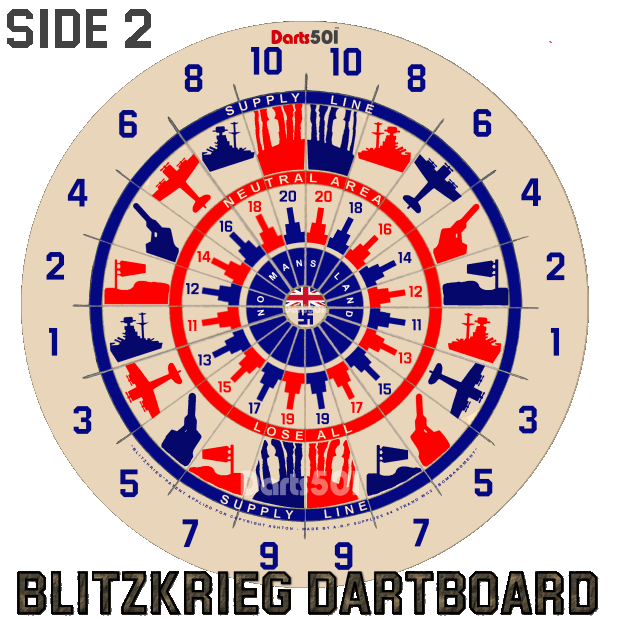
Bliztkrieg / Blitzkrieg Bombardment - Dartboard
Combat Dealers: World War II, ARP Supplied Dartboard
Bruce Crompton wasn’t correct. Another was sold on eBay for £435 in 2021. But the game looks detailed, and the board looks like it has been stencil-printed; hence, it is likely that a number were made. Details on the dartboard that are not easily visible state areas were named ‘Supply line’, ‘Neutral Area Lose All’, and ‘No Man’s Land’. The Blitzkrieg Bombardment dartboard was made from cork by Ashton Reynolds Purvis Supplies LTD (A.R.P Supplies) 76-86 Strand, London WC2
Here are more details:
The dartboard is two-sided. A standard London Clock Dartboard features on one side with a natural, red and dark blue colour. The other is different, a game featuring warships, planes, artillery guns and more.
The Blitzkrieg Bombardment Dartboard isn’t just a standard dartboard with different painted segments, although you could be forgiven if you think it was. The playing surface is the same dimensions as a standard board and has 20 segmented areas as per a standard board but turned 9°.
The centre bullseye doesn’t exist, and the outer-bull area is divided horizontally into two. The top half features the Union Flag and the Nazi Swastika on the bottom.
Surrounding the bull area is a section painted dark blue call ‘NO MANS LAND’, and the remaining area up to the band we usually call the treble ring that states ‘Neutral Area Lose All’. The board illustrates number segments ranging from 11-20. Ten of the numbers are in red, and the other ten is in dark blue.
The treble ring is painted red with the words ‘Neutral Area Lose All’. We can only assume without a set of rules; it means hitting the ring may indicate losing the score you just achieved or total loss of your score.
Between the treble and double ring features Second World War illustrations of Battleships, Planes, Artillery Guns and possible illustrations of a Windsock posted to the ground and, for a better word, a forest, although it could be a bombed area. There are four of each of these graphics, two of which are coloured red and two in dark blue.
The double ring is dark blue with the words ‘Supply Area’ printed on it. Again without the rules, it is unclear what part it plays in the game. We can assume that it may be hit followed by another are to count, a bit like double off in a 501 game.
The external, non-playing area numbers the outer part of the segments 1-10, i.e. these numbers are all painted in dark blue and are ten less than the inner segment area.
Both sides of the dartboard had the numbers printed upon them. The dartboard London clock side was not designed to be turned, and the board hung from a single top looped wire. The board was made from cork, a common dartboard material used at the time.
I have recreated the board the best I can using stills from the Combat Dealers video broadcast. However, how this game is played still eludes me., and I have unsuccessfully looked for the official rules for the Blitzkrieg Bombardment Dartboard. However, the dartboard, although visually different, has strong similarities to the Plonk dartboard that was made in the same era.
This is how I believe the game was played based on Plonk.
Rules (Non-Official – Based on other similar styled dartboards at the time) Game Version One
The two sides need to be determined.
A throw for what I will call the Bullsysye features both English and Nazis emblems. If the first player hits either emblem, that is the side they will play for the game's duration. Should the throw miss, the next player throws until the one hits the area to decide the sides. If played in a group of four or more, all players throw for this section until an even number of players are reached on each side.
The individual or team starts with 365 points each.
The objective is to reduce their score to zero by hitting their opponent's targets, red for the British, Blue for the Nazis.
If a player hits no mans land, then they don't score with that dart.
If a player hits the neutral ring zone, they lose their score and throw for that turn.
If a player hits the supply ring, they add the value rather than subtract to their score (i.e., the supply of the item increases.)
Rules (Non-Official – Based on other similar styled dartboards at the time) Game Version Two
Since this is a British game, no player at the time would have wished to play on the Nazis side. Here, the game is played very similar to Plonk.
There is no need to determine sides, as all play on the British Side.
The individual or team starts with 365 (as per Plonk, I assume, represents a full year of combat) points again, and the object is to reduce the score to zero.
Each player alternately throws three darts and tries to eliminate the Nazis by hitting their ships, guns, aircraft etc. - deducting the number scored from their total. The number is added to their score if a player hits one of the Allies (ships, guns, aircraft, etc.)
No Mans Land – nothing is scored
If a player hits the neutral ring zone, they lose their score and throw for that turn.
If a player hits the supply ring of the Nazis, the score is doubled and subtracted from their remaining number. Should a Player hit an Allie's supply ring segment, the value is doubled and added to their remaining score.
A shorter version (like Plonk) can be played by reducing the starting number.
Knocking the Nasties (Non-Official – Based on other similar styled dartboards at the time) Game Version Three
Based on Plonk, this game can be played on the Blitzkrieg dartboard.
The objective is to liquidate the enemy in the following order, starting with the least important at the top, and the player or team first to succeed is the winner.
1 Battleship
2 Miltary Holding
3 Aircraft
4 Artillery Gun
5 Artillery Gun
6 Aircraft
7 Miltary Holding
8 Battleship
9 Bomed Area
10 Bomed Area
11 cannon
12 Cannon
13 Cannon
14 Cannon
15 Cannon
17 Cannon
18 Cannon
19 Cannon
20 Cannon
Swastika (Lower Bullseye)
Winning the War (Non-Official – Based on other similar styled dartboards at the time) Game Version Four
Based on Plonk, this game can be played on the Blitzkrieg dartboard.
One player can play this game alone, which is equivalent to playing against a bogey.
We are prepared for a war lasting three years, 1,095 days. See if you can shorten the war by scoring as much as possible with 18 darts. Your total score value is deducted from the 1,095
World War II Civil Defence – WW2 Blitzkrieg Bombardment Dartboard – Dartboard and Poster
![]()
Can you help?

Do you have one of these dartboards? Do you know the rules or anyone that can recall playing on one?
There were lots of wartime dartboards made, and some may now be just lost in time. However, many of you like to find out the history of the sport, and how and where it was played. The Blitzkrieg Bombardment Dartboard is an example of dartboard history, and it would be good to publish how the game was played.
![]()
MI9 / IS9 Three Witches Badge
The three witches’ badge in itself is intriguing and very unusual. But what does it refer too, and why did MI9 / IS9 adopt this as an emblem?
My research has taken me down a path I never thought I would enter when researching the recreational game of darts. Espionage, trickery, deception, and illusion were all part of Military Intelligence, but why advertise a unit in this way at all!
From the little I have managed to find out, the three witches may refer to a reference to a famous First World War escape book, The Road to En-Dor by E.H.Jones
Some of the prisons in this book used Ouija board, and spiritualism with their daily lives (for those who believed) to gain information on battles and help them to freedom.
The book also uses a forerunner quote from Rudyard Kipling
“Oh the road to En-dor is the oldest road
And the craziest road of all!
Straight it runs to the Witch’s abode,
As it did in the days of Saul,
And nothing is changed of the sorrow in store
For such as go down on the road to En-dor!”
— Rudyard Kipling.

![]()
World War I - Darts Used in War
WWI and the Troop Piercing Darts
When researching darts and dartboards, you occasionally come across if formation that some readers find fascinating. Although the following information isn't about the darts we throw as a sport, it does have a place on this page. Darts used in War!
In WWI, darts was thriving in the UK as a Pub Tap Rooms as a game; the military also had other ideas for the small metal missiles. Darts again became an item of War.
The medieval archer's arrow, crossbow bolt and indeed thrown heavy dart missile from battlements took yet another twist in its long history as a deadly missile throw from the aircraft.
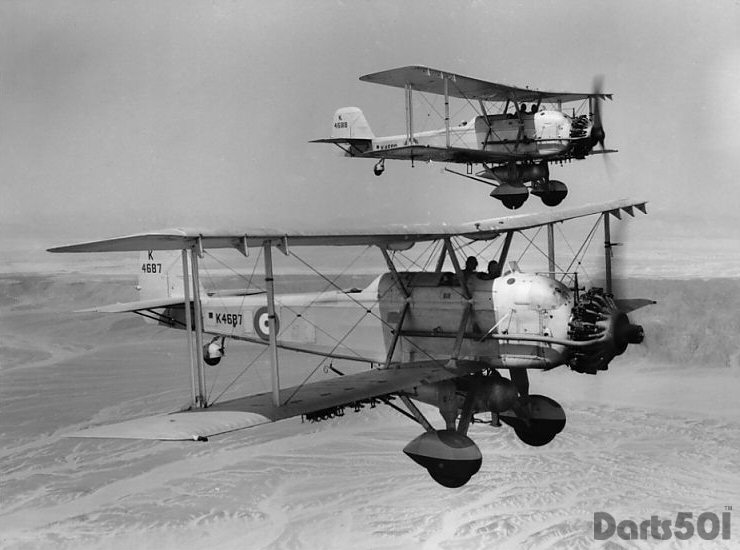
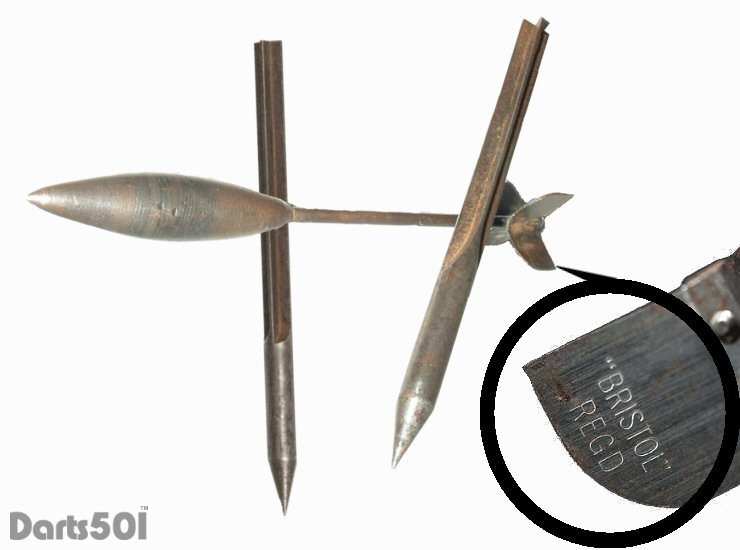
The darts, known as fléchettes, French for "little arrow" or "dart", varied in design, and were used on both sides of WWI. They were designed to be dropped from aircraft but contained no explosive charge. However, they were lethal. The small dart was capable of penetrating soft canopy cover and several inches of sand.
Fléchettes were made from steel rods and had a sharpened point at one end and grooved fins at the other. The Italians initially invented them in 1911-1912. During the First World War, the French first used them in 1914, although they were also later used by the British Royal Flying Corp and Germans Air Force. The Germans, however, added stamped descriptions on their darts points regarding the development of the use of fléchettes. They stamped some of their fléchettes (the ones that were similar to the French ones), 'INVENTION FRANCAIS, FABRICATION ALLEMANDE' [French invention, German made] for their French enemy to read.

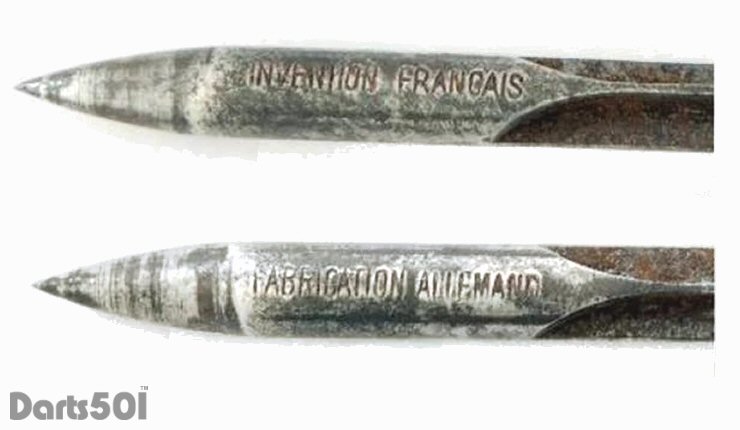
The fléchettes were dropped from aeroplanes and airships in huge numbers. Each of the canisters would hold anything from twenty and 250 individual darts. One French airman dropped an estimated 18,000 in a single day over the German-controlled lines.
The high-altitude drop would give the fléchettes sufficient momentum to allow them to pierce the heads or bodies of enemy soldiers or indeed civilians. The canisters of fléchettes were attached under the fuselage of the aircraft, and a pull of a wire opened the bottom of the canister, releasing the fléchettes on the enemy below.
The British also used them to try and bring down German airships. They were again dropped from aircraft which flew above the airship. However, it failed to work, in the same way firing standard ammunition rounds at the airships failed. The fléchettes were able to penetrate the outer envelope of the airship but did not cause enough damage to bring them down. The Incendiary weapons, later used, were generally more successful in this feat.
Dropping the fléchettes directly on troops and civilians was, however, was slightly more successful. There are accounts of men being killed by fléchettes. The records state the fléchettes made thin but deep wounds.
Although Fléchettes were primarily used early in the early part of WWI, some were still being used as late as January 1917. The British found them to be unsatisfactory as the flechettes had to score a direct hit. However, once released from the canister, there was no opportunity to direct them. They were regarded as less effective than a bomb, which could inflict a much more comprehensive range of damage.
Further reading and more information regarding darts used in WWI and other conflicts:
The Vintage News | The Daily Mail Online | Might History | Pioneers Of Aviation | Wikipedia - Flechette | Imperial War Museums
Acknowledgements | Privacy, Cookies & Terms of Use | FAQ



